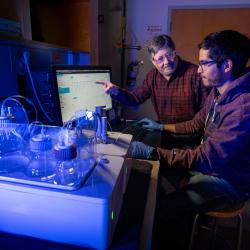UMD’s Pratyush Tiwary Named to 2019 “Future of Biochemistry” List
Tiwary uses statistical physics, theoretical chemistry and artificial intelligence to develop algorithms that simulate the behavior of molecules on the atomic level
University of Maryland’s Pratyush Tiwary, an assistant professor of chemistry and biochemistry with a joint appointment in the Institute for Physical Science and Technology, is one of 30 early-career scientists named to the 2019 “Future of Biochemistry” list in the journal Biochemistry.
 “As a theorist, receiving this award is really nice because it means the community feels that my tools can be used to make a real impact in biochemistry,” Tiwary said.
“As a theorist, receiving this award is really nice because it means the community feels that my tools can be used to make a real impact in biochemistry,” Tiwary said.
Tiwary develops methods for simulating the behavior of molecular systems, such as proteins, on the atomic scale. These simulations have applications in many areas, including the pharmaceutical industry.
“All drugs—from aspirin to chemotherapy—work by interacting with their targets at the atomic level,” Tiwary said. “Understanding that interaction is key to designing and improving drugs.”
Drugs interact with their targets for a fraction of a second, which is too short for scientists to easily observe in the laboratory. Tiwary simulates these interactions using statistical physics. In particular, he uses statistical mechanics, a branch of physics that uses mathematical and statistical tools to describe how large groups of atoms or molecules physically behave, which allows scientists to observe the interactions for as long as needed.
However, calculating a millisecond’s worth of an interaction can take a year, even on a powerful supercomputer. To address that obstacle, Tiwary combines artificial intelligence with statistical mechanics.
“Artificial intelligence can tell you what parameters or independent factors are the most important ones in a given complex system,” Tiwary said. “By focusing on those parameters, we can carry out simulations that would otherwise take the lifetime of the universe to calculate.”
Tiwary first learned about using statistical mechanics as a tool for materials science research as a student at the Indian Institute of Technology in Varanasi, where he earned a B.Tech. in metallurgical engineering in 2007. At the California Institute of Technology, where he received a Ph.D. in materials science in 2012, Tiwary became interested in applying statistical mechanics to other fields such as chemistry. Then, as a postdoctoral scholar at the Swiss Federal Institute of Technology (ETH) in Zürich and at Columbia University, Tiwary further explored the intersection of statistical mechanics and chemistry.
In 2017, Tiwary joined UMD to build on the university’s pioneering efforts and strengths in the field of statistical mechanics, while also exploring its intersection with other disciplines like data analytics and computer science.
“Maryland has great programs in computer science, chemistry, biophysics and chemical physics, so I knew it would be a good place to think about both statistical mechanics and artificial intelligence at the same time,” Tiwary said. “Maryland also encourages interdisciplinary work, which has given my research a huge boost.”
Although Tiwary calls himself a theorist, he firmly believes that his simulations should help people in the real world. For instance, Tiwary collaborates with Charles Vinson at the National Cancer Institute on a project funded by the NCI-UMD Partnership for Integrative Cancer Research. They are searching for the binding target of Zta, a protein found in a common virus called Epstein-Barr.
Zta is a transcription factor, meaning that it binds to and activates specific sequences of DNA. However, scientists do not currently know what those sequences are, even though they believe that the sequences are extremely important.
“The Epstein-Barr virus is inactive in most people, but when it becomes active, it can cause cancer,” Tiwary said. “We think that Zta is responsible for activating the virus, so we are using our algorithms to narrow down Zta’s possible targets. Then, experimentalists can test these potential targets in the laboratory.”
Going forward, Tiwary hopes to apply new simulation methods that he and his group developed toward drug discovery. With the help of artificial intelligence techniques, these methods successfully modeled a small molecular system that mimics a drug binding to its target in one-twentieth of the amount of time needed by other popular methods.
Tiwary published a pilot study on these methods in The Journal of Chemical Physics in May 2018. In December 2018, Tiwary followed up with a study in the Journal of Chemical Theory and Computation that successfully used the methods to model a small molecule unbinding from lysozyme, an enzyme that protects people against bacterial infection.
“If you want to use a drug to block the action of a certain protein, you have to know what part of the protein to target,” Tiwary said. “Our methods can get you down from a billion possible compounds to a few hundred, making it possible to do tests in the laboratory.”
###
The research paper, “Toward Achieving Efficient and Accurate Ligand-Protein Unbinding with Deep Learning and Molecular Dynamics through RAVE,” João Marcelo Lamim Ribeiro and Pratyush Tiwary, was published in Journal of Chemical Theory and Computation in December 2018.
The research paper, “Reweighted autoencoded variational Bayes for enhanced sampling (RAVE),” João Marcelo Lamim Ribeiro, Pablo Bravo, Yihang Wang and Pratyush Tiwary, was published in The Journal of Chemical Physics in May 2018.
Media Relations Contact: Irene Ying, 301-405-5204, zying@umd.edu
University of Maryland
College of Computer, Mathematical, and Natural Sciences
2300 Symons Hall
College Park, MD 20742
www.cmns.umd.edu
@UMDscience
About the College of Computer, Mathematical, and Natural Sciences
The College of Computer, Mathematical, and Natural Sciences at the University of Maryland educates more than 9,000 future scientific leaders in its undergraduate and graduate programs each year. The college’s 10 departments and more than a dozen interdisciplinary research centers foster scientific discovery with annual sponsored research funding exceeding $175 million.







